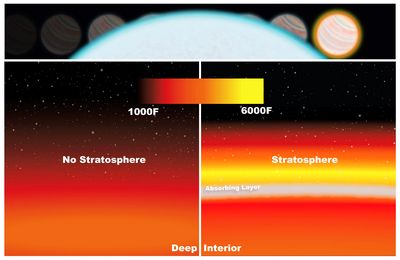
Researchers using NASA's Hubble Space Telescope have detected a stratosphere and temperature inversion in the atmosphere of a planet several times the mass of Jupiter, called WASP-33b. Earth's stratosphere sits above the troposphere, the turbulent, active-weather region that reaches from the ground to the altitude where nearly all clouds top out. In the troposphere, the temperature is warmer at the bottom — ground level — and cools down at higher altitudes. The stratosphere is just the opposite: There, the temperature rises at higher altitudes. This is called a temperature inversion, and it happens because ozone in the stratosphere absorbs some of the sun's radiation, preventing it from reaching the surface and warming this layer of the atmosphere. Similar temperature inversions occur in the stratospheres of other planets in our solar system, such as Jupiter and Saturn. But WASP-33b is so close to its star that its atmosphere is a scathing 10,000 degrees Fahrenheit, and its atmosphere is so hot the planet might actually have titanium oxide rain. For a little more insight into the project see this:http://hubblesite.org/newscenter/archive/releases/2015/25/ |
